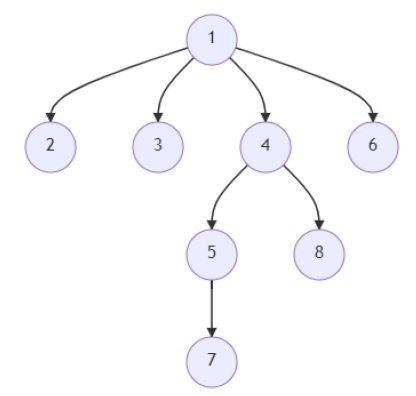
 Data Structure
Data Structure Networking
Networking RDBMS
RDBMS Operating System
Operating System Java
Java MS Excel
MS Excel iOS
iOS HTML
HTML CSS
CSS Android
Android Python
Python C Programming
C Programming C++
C++ C#
C# MongoDB
MongoDB MySQL
MySQL Javascript
Javascript PHP
PHP
- Selected Reading
- UPSC IAS Exams Notes
- Developer's Best Practices
- Questions and Answers
- Effective Resume Writing
- HR Interview Questions
- Computer Glossary
- Who is Who
Program to find length of the longest path in an n-ary tree in Python
Suppose we have an edge list where each items are holding (u, v) represents u is parent of v. We have to find the length of the longest path in the tree. The path length is 1 + number of nodes in that path.
So, if the input is like

then the output will be 5, because the path is [1, 4, 5, 7], there are 4 nodes in total, so path length is 1 + 4 = 5.
To solve this, we will follow these steps −
- g := adjacency list of the graph from given edge list
- d := a new map
- Define a function bfs() . This will take o
- d[o] := 1
- f := o
- q := [o]
- for each x in q, do
- for each y in g[x], do
- if y is not in d, then
- d[y] := d[x] + 1
- if d[y] > d[f], then
- f := y
- insert y in q
- if y is not in d, then
- for each y in g[x], do
- return f
- From the main method, do the following −
- for each o in g, do
- f := bfs(o)
- d := a new map
- return d[bfs(f)]
- return 0
Example
Let us see the following implementation to get better understanding −
def solve(edges):
g = {}
for u, v in edges:
if u not in g:
g[u] = []
g[u] += (v,)
if v not in g:
g[v] = []
g[v] += (u,)
d = {}
def bfs(o):
d[o] = 1
f = o
q = [o]
for x in q:
for y in g[x]:
if y not in d:
d[y] = d[x] + 1
if d[y] > d[f]:
f = y
q += (y,)
return f
for o in g:
f = bfs(o)
d = {}
return d[bfs(f)]
return 0
edges = [(1, 2),(1, 3),(1, 4),(4, 5),(5,7),(1,6),(4,8)]
print(solve(edges))
Input
[(1, 2),(1, 3),(1, 4),(4, 5),(5,7),(1,6),(4,8)]
Output
5

Advertisements
